
List of Hungarian rulers
Encyclopedia
This is a List of rulers of Hungary, which includes the grand prince
s (895–1000), the king
s (1000–1918), and regent
Miklós Horthy
(1920–1944).
For a list of presidents until present day, see List of heads of state of Hungary.
Grand Prince
The title grand prince or great prince ranked in honour below emperor and tsar and above a sovereign prince .Grand duke is the usual and established, though not literal, translation of these terms in English and Romance languages, which do not normally use separate words for a "prince" who reigns...
s (895–1000), the king
Monarch
A monarch is the person who heads a monarchy. This is a form of government in which a state or polity is ruled or controlled by an individual who typically inherits the throne by birth and occasionally rules for life or until abdication...
s (1000–1918), and regent
Regent
A regent, from the Latin regens "one who reigns", is a person selected to act as head of state because the ruler is a minor, not present, or debilitated. Currently there are only two ruling Regencies in the world, sovereign Liechtenstein and the Malaysian constitutive state of Terengganu...
Miklós Horthy
Miklós Horthy
Miklós Horthy de Nagybánya was the Regent of the Kingdom of Hungary during the interwar years and throughout most of World War II, serving from 1 March 1920 to 15 October 1944. Horthy was styled "His Serene Highness the Regent of the Kingdom of Hungary" .Admiral Horthy was an officer of the...
(1920–1944).
For a list of presidents until present day, see List of heads of state of Hungary.
895–1301
| Portrait | Ruler | Began | Ended | Remarks |
|---|---|---|---|---|
| High Prince Álmos High Prince Álmos Álmos , the first Grand Prince of the Magyars . The Gesta Hungarorum records that his father was Ügyek, while the Chronicon Pictum mentions his father as Előd ; his mother was Emese.-Birth:The medieval chronicle recounts the story of his... |
c. 858 | c. 895 | The first Hungarian leader, and father of Árpád. He strengthened the alliance between the other six Magyar tribal leaders. | |
| |
Árpád Árpád Árpád was the second Grand Prince of the Hungarians . Under his rule the Hungarian people settled in the Carpathian basin. The dynasty descending from him ruled the Hungarian tribes and later the Kingdom of Hungary until 1301... |
c. 895 | c. 907 | Led the Magyars into Central Europe Central Europe Central Europe or alternatively Middle Europe is a region of the European continent lying between the variously defined areas of Eastern and Western Europe... around 896. According to the dual system of rulership (similar to the Khazars), he was the actual leader with Kurszán Kurszán Kurszán , the Magyar sacral prince, was a partner ruler besides Árpád till his death. He had a crucial role in the Hungarian Conquest . In 892/893 together with Arnulf of Carinthia he attacked Great Moravia to secure the eastern borders of the Frankish Empire. Arnulf gave him all the captured... as sacral prince. |
| Portrait | Ruler | Began | Ended | Remarks | |
|---|---|---|---|---|---|
| The rulers of the first half of the 10th century are often disputed, as the Hungarian nation consisted of several tribes led by various leaders. The most frequently proposed are: | |||||
| Szabolcs | c. 907 | ? | |||
| Tarhos | c. 907 | c. 922 | |||
| Zoltán Zoltán of Hungary Zoltán , also known as Zaltas and Solt, according to the mediaeval chronicles, was the third Grand Prince of the Magyars from 907 to 947.He was the youngest son of Árpád... |
c. 907 | c.947 | Also known as Zaltas. The youngest (fifth) son of Árpád, and Third Grand Prince of the Hungarians Grand Prince of the Hungarians Grand Prince was the title used by contemporary sources to name the leader of the federation of the Hungarian tribes in the tenth century.-The title:... (Magyars). |
||
| Fajsz Fajsz Fajsz , also known as Fali or Falicsi, Grand Prince of the Magyars .Fajsz was the son of Jutas, the third son of Árpád, and ruled over the Magyar tribes at the time of the Byzantine Emperor Kōnstantinos Porhyrogennētos.... |
c. 947 | c. 955 | Also known as Fali or Falicsi. Son of Jutocsa (Jutas) the third son of Árpád. | ||
| Taksony Taksony of Hungary Taksony , Grand Prince of the Hungarians .Taksony was the son of Zoltán , the fourth son of Árpád, the second Grand Prince of the Hungarians... |
c. 955 | c. 972 | Son of Zoltán (Zaltas) | ||
| Géza Géza of Hungary Géza , Grand Prince of the Hungarians .Géza was the son of Taksony of Hungary, Grand Prince of the Hungarians and his Pecheneg or Bulgar wife. Géza's marriage with Sarolt, the daughter of Gyula of Transylvania, was arranged by his father.After his father's death , Géza followed him as Grand Prince... |
c. 972 | 997 | Son of Taksony | ||
| Stephen I (Szent István) |
997 | 1000 | Son of Géza. Last Grand Prince. | ||
| Portrait | Ruler | Began | Ended | Remarks | |
|---|---|---|---|---|---|
| |
Stephen I | 1000 | 15 August 1038 | Son of Géza. Proclaimed the first King of Hungary. | |
| Dynastic struggle 1038–1046 | |||||
| |
Peter Orseolo | 15 August 1038 | 1041 | Also known as Peter I the Venetian. Grandson of Géza. Dethroned. | |
| Samuel Aba Samuel Aba of Hungary Samuel Aba , King of Hungary , Palatine of Hungary .-King of Hungary:Samuel was from Northern Hungary, Castle Gonce / Castle Abaújvár, County of Aba... |
1041 | 5 July 1044 | Leader of the Kabar Kabar The Khavars or erroneously Kabars were Khazarians, therefore Turkic people who joined to the Magyars in the 8th century.- History :... tribe. Married Géza's daughter Gizella. |
||
| |
Peter Orseolo | 1044 | 1046 | Reinstated, but dethroned again. | |
| Vatha pagan rising Vatha pagan rising The Vata pagan uprising was a Hungarian rebellion which in 1046 brought about the overthrow of King Peter Urseolo, the martyrdom of St. Gellért and the reinstatement of the Árpád dynasty on the Hungarian throne.- Background :... 1046–1047 |
|||||
| Andrew I | 1047 | 1061 | Árpád dynasty restored | ||
| Béla I | 1061 | August 1063 | brother of Andrew I | ||
| Solomon Solomon of Hungary Solomon , King of Hungary . He was crowned as a child during his father's lifetime in order to ensure his succession, but his uncle Béla managed to dethrone his father and ascend to the throne... |
August 1063 | 28 October 1074 | son of Andrew I | ||
| Géza I Géza I of Hungary Géza I was King of Hungary from 1074 until his death. During King Solomon's rule he governed, as Duke, one third of the Kingdom of Hungary. Afterwards, Géza rebelled against his cousin's reign and his followers proclaimed him king... |
28 October 1074 | 25 April 1077 | son of Béla I | ||
| |
St. Ladislaus | 25 April 1077 | 29 July 1095 | son of Béla I | |
| Coloman | 29 July 1095 | 3 February 1116 | son of Géza I. | ||
| Stephen II Stephen II of Hungary Stephen II , King of Hungary and Croatia, ruled from 1116 until 1131. He was crowned as a child during his father's lifetime who wanted to ensure Stephen's succession against his brother, Duke Álmos. Stephen's reign was characterized by frequent struggles with neighbouring countries... |
3 February 1116 | 3 April 1131 | Son of Kálmán | ||
| Béla II the Blind Béla II of Hungary Béla II the Blind , King of Hungary and Croatia . Still as a child, Béla was blinded by his uncle, King Coloman who wanted to ensure the succession of his own son, the future King Stephen II... |
3 April 1131 | 13 February 1141 | grandson of Géza I, son of Álmos, Kálmán's younger brother | ||
 |
Géza II Géza II of Hungary Géza II , , King of Hungary, King of Croatia, Dalmatia and Rama . He ascended the throne as a child and during his minority the kingdom was governed by his mother and uncle... |
13 February 1141 | 31 May 1162 | son of Béla II | |
| Stephen III Stephen III of Hungary Stephen III , King of Hungary King of Croatia and Dalmatia . He ascended the throne as a child and he had to stand up against his uncles who usurped the crown supported by the Byzantine Empire... |
31 May 1162 | 4 March 1172 | son of Géza II | ||
| Ladislaus II Ladislaus II of Hungary Ladislaus II , King of Hungary. As a younger son, he was able to ascend to the throne only with the assistance of the Byzantine Empire against his nephew, King Stephen III after his brother's death... |
31 May 1162 | 14 January 1163 | rebel anti-king, younger brother of Géza II. | ||
| Stephen IV Stephen IV of Hungary Stephen IV , King of Hungary . In his youth, he rebelled against his brother, King Géza II of Hungary and had to flee to the Court of the Byzantine Emperor, Manuel I Komnenos... |
14 January 1163 | June 1163 | rebel anti-king, younger brother of Géza II. | ||
| Béla III Béla III of Hungary Béla III was King of Hungary and Croatia . He was educated in the court of the Byzantine Emperor Manuel I who was planning to ensure his succession in the Byzantine Empire till the birth of his own son... |
4 March 1172 | 13 April 1196 | younger brother of Stephen III. | ||
| Emeric Emeric of Hungary Emeric I , , King of Hungary and Croatia . He was crowned during his father's lifetime, but after his father's death he had to fight against his brother, Andrew, who forced Emeric to assign the government of Croatia and Dalmatia to him... |
13 April 1196 | 30 November 1204 | son of Béla III. | ||
| Ladislaus III Ladislaus III of Hungary Ladislaus III was King of Hungary. and Croatia .He was the only son of King Emeric, King of Hungary and his queen, Infanta Constance of Aragon.... |
30 November 1204 | 7 May 1205 | son of Imre, crowned and died as a child | ||
| Andrew II Andrew II of Hungary Andrew II the Jerosolimitan was King of Hungary and Croatia . He was the younger son of King Béla III of Hungary, who invested him with the government of the Principality of Halych... |
7 May 1205 | 21 September 1235 | brother of Imre | ||
 |
Béla IV Béla IV of Hungary Béla IV , King of Hungary and of Croatia , duke of Styria 1254–58. One of the most famous kings of Hungary, he distinguished himself through his policy of strengthening of the royal power following the example of his grandfather Bela III, and by the rebuilding Hungary after the catastrophe of the... |
21 September 1235 | 3 May 1270 | son of Andrew II, the "second founder" after the First Mongol invasion (1241–42) | |
| Stephen V Stephen V of Hungary Stephen V , was King of Hungary from 1270 to 1272.-Early years:... |
3 May 1270 | 6 August 1272 | son of Béla IV. | ||
 |
Ladislaus IV the Cuman | 6 August 1272 | 10 July 1290 | son of Steven V.; unsuccessful Mongol invasion; lived with the nomad Cuman tribes | |
| Andrew III | 4 August 1290 | 14 January 1301 | grandson of Andrew II, born in Venice; last of the Árpád dynasty Árpád dynasty The Árpáds or Arpads was the ruling dynasty of the federation of the Hungarian tribes and of the Kingdom of Hungary . The dynasty was named after Grand Prince Árpád who was the head of the tribal federation when the Magyars occupied the Carpathian Basin, circa 895... |
||
1301–1541
| Portrait | Ruler | Began | Ended | Remarks |
|---|---|---|---|---|
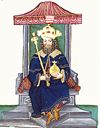 |
Wenceslaus of Bohemia Wenceslaus III of Bohemia Wenceslaus III Premyslid was the King of Hungary , King of Bohemia and the king of Poland .... |
1301 | 1305 | King of Bohemia, elected as King of Hungary but not universally recognized |
| Portrait | Ruler | Began | Ended | Remarks |
|---|---|---|---|---|
| Otto of Bavaria (Béla V) Otto III, Duke of Bavaria Otto III of Bavaria , member of the Wittelsbach dynasty, was Duke of Lower Bavaria from 1290 to 1312 and disputably King of Hungary and Croatia between 1305 and 1307 as Béla V.-Family:... |
6 December 1305 | 1308 | Duke of Lower Bavaria as Otto III, was not universally recognized | |
| Portrait | Ruler | Began | Ended | Remarks |
|---|---|---|---|---|
| |
Charles I Charles I of Hungary Charles I , also known as Charles Robert , was the first King of Hungary and Croatia of the House of Anjou. He was also descended from the old Hungarian Árpád dynasty. His claim to the throne of Hungary was contested by several pretenders... (I. Károly) |
20 August 1310 | 16 July 1342 | established the Angevin dynasty Capetian House of Anjou The Capetian House of Anjou, also known as the House of Anjou-Sicily and House of Anjou-Naples, was a royal house and cadet branch of the direct House of Capet. Founded by Charles I of Sicily, a son of Louis VIII of France, the Capetian king first ruled the Kingdom of Sicily during the 13th century... in Hungary. |
| Louis I the Great (Nagy Lajos) | 16 July 1342 | 11 September 1382 | also became King of Poland Poland Poland , officially the Republic of Poland , is a country in Central Europe bordered by Germany to the west; the Czech Republic and Slovakia to the south; Ukraine, Belarus and Lithuania to the east; and the Baltic Sea and Kaliningrad Oblast, a Russian exclave, to the north... (1370) |
|
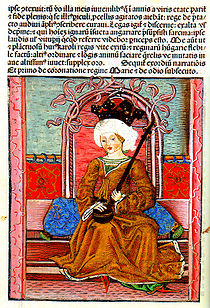 |
Mary I Mary of Hungary Mary of Anjou was queen regnant of Hungary from 1382 until her death in 1395.-Childhood:... (I. Mária) |
11 September 1382 | 17 May 1395 | married Sigismund Sigismund, Holy Roman Emperor Sigismund of Luxemburg KG was King of Hungary, of Croatia from 1387 to 1437, of Bohemia from 1419, and Holy Roman Emperor for four years from 1433 until 1437, the last Emperor of the House of Luxemburg. He was also King of Italy from 1431, and of Germany from 1411... of Luxemburg |
 |
Charles II the Small (Kis Károly) | 31 December 1385 | 24 February 1386 | also King of Naples, in opposition to Mary |
| Portrait | Ruler | Began | Ended | Remarks |
|---|---|---|---|---|
| Sigismund I Sigismund, Holy Roman Emperor Sigismund of Luxemburg KG was King of Hungary, of Croatia from 1387 to 1437, of Bohemia from 1419, and Holy Roman Emperor for four years from 1433 until 1437, the last Emperor of the House of Luxemburg. He was also King of Italy from 1431, and of Germany from 1411... (Zsigmond) |
31 March 1387 | 9 December 1437 | later also Roman-German King (since 1410), King of Bohemia Bohemia Bohemia is a historical region in central Europe, occupying the western two-thirds of the traditional Czech Lands. It is located in the contemporary Czech Republic with its capital in Prague... (since 1419), Holy Roman Emperor Holy Roman Emperor The Holy Roman Emperor is a term used by historians to denote a medieval ruler who, as German King, had also received the title of "Emperor of the Romans" from the Pope... (since 1433) |
|
| Portrait | Ruler | Began | Ended | Remarks |
|---|---|---|---|---|
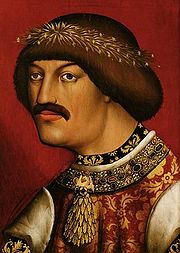 |
Albert I | 1 January 1438 | 27 October 1439 | son-in-law of Sigismund, also Roman-German King, King of Bohemia, Duke of Austria Austria Austria , officially the Republic of Austria , is a landlocked country of roughly 8.4 million people in Central Europe. It is bordered by the Czech Republic and Germany to the north, Slovakia and Hungary to the east, Slovenia and Italy to the south, and Switzerland and Liechtenstein to the... |
| Kingship disputed between Vladislaus I and Ladislaus Posthumus | |||||
| Portrait | Ruler | Began | Ended | Remarks |
|---|---|---|---|---|
 |
Vladislaus I | 15 May 1440 | 10 November 1444 | also King of Poland |
| Portrait | Ruler | Began | Ended | Remarks |
|---|---|---|---|---|
| Ladislaus V the Posthumus | 15 May 1440 | 23 November 1457 | born in 1440 after his father's death, spent most of his life in captivity. | |
| Portrait | Ruler | Began | Ended | Remarks |
|---|---|---|---|---|
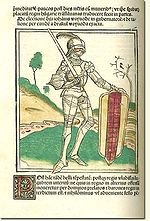 |
John Hunyadi John Hunyadi John Hunyadi John Hunyadi (Hungarian: Hunyadi János , Medieval Latin: Ioannes Corvinus or Ioannes de Hunyad, Romanian: Iancu (Ioan) de Hunedoara, Croatian: Janko Hunjadi, Serbian: Сибињанин Јанко / Sibinjanin Janko, Slovak: Ján Huňady) John Hunyadi (Hungarian: Hunyadi János , Medieval Latin: ... (Hunyadi János) |
1446 | 1453 | ruled as regent. Fought with great success against the Ottomans |
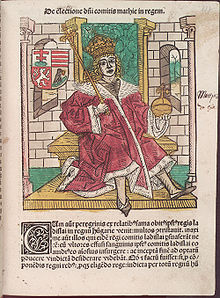 |
Matthias I Corvinus Matthias Corvinus of Hungary Matthias Corvinus , also called the Just in folk tales, was King of Hungary and Croatia from 1458, at the age of 14 until his death... (Corvin Mátyás or Hunyadi Mátyás) |
24 January 1458 | 6 April 1490 | son of John Hunyadi, also King of Bohemia |
| Portrait | Ruler | Began | Ended | Remarks |
|---|---|---|---|---|
| Vladislaus II | 15 July 1490 | 13 May 1516 | also King of Bohemia | |
| Louis II | 13 May 1516 | 29 August 1526 | also King of Bohemia; killed in the Battle of Mohács Battle of Mohács The Battle of Mohács was fought on August 29, 1526 near Mohács, Hungary. In the battle, forces of the Kingdom of Hungary led by King Louis II of Hungary and Bohemia were defeated by forces of the Ottoman Empire led by Sultan Suleiman the Magnificent.... |
|
| Portrait | Ruler | Began | Ended | Remarks |
|---|---|---|---|---|
| Kingship disputed between Ferdinand of Austria and John Zápolya during the Ottoman invasion Suleiman the Magnificent Suleiman I was the tenth and longest-reigning Sultan of the Ottoman Empire, from 1520 to his death in 1566. He is known in the West as Suleiman the Magnificent and in the East, as "The Lawgiver" , for his complete reconstruction of the Ottoman legal system... |
||||
 |
Ferdinand I, Holy Roman Emperor Ferdinand I, Holy Roman Emperor Ferdinand I was Holy Roman Emperor from 1558 and king of Bohemia and Hungary from 1526 until his death. Before his accession, he ruled the Austrian hereditary lands of the Habsburgs in the name of his elder brother, Charles V, Holy Roman Emperor.The key events during his reign were the contest... (Ferdinánd) |
16 December 1526 | 25 July 1564 | claimed the throne according to the agreement between the House of Jagiellon and the House of Habsburg |
1541–1780
| Portrait | Ruler | Began | Ended | Remarks |
|---|---|---|---|---|
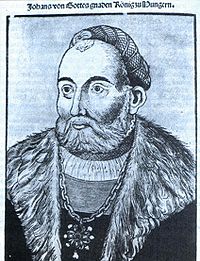 |
John I John Zápolya John Zápolya was King of Hungary from 1526 to 1540. His rule was disputed by Archduke Ferdinand I, who also claimed the title King of Hungary between 1526 and 1540. He was the voivode of Transylvania before his coronation.- Biography :... (Szapolyai János) |
10 November 1526 | 22 July 1540 | Also claimed the throne, with support of Hungarian nobles and later Suleiman the Magnificent Suleiman the Magnificent Suleiman I was the tenth and longest-reigning Sultan of the Ottoman Empire, from 1520 to his death in 1566. He is known in the West as Suleiman the Magnificent and in the East, as "The Lawgiver" , for his complete reconstruction of the Ottoman legal system... . |
| John II John II Sigismund Zápolya John II Sigismund Zápolya was King of Hungary from 1540 to 1570 and Prince of Transylvania from 1570–1571.-Family:The son of King John I and Isabella Jagiełło, he succeeded his father as an infant... (Szapolyai János Zsigmond) |
22 July 1540 | 16 August 1570 | son of John Zápolya; renounced his claim in 1570 in favour of Emperor Maximilian II. | |
| Hungary was effectively split into three parts: Royal Hungary Royal Hungary The Kingdom of Hungary between 1538 and 1867 was part of the lands of the Habsburg Monarchy, while outside the Holy Roman Empire.After Battle of Mohács, the country was ruled by two crowned kings . They divided the kingdom in 1538... in the north and west, Ottoman Hungary Ottoman Hungary History of Ottoman Hungary refers to the history of parts of the Ottoman Empire situated in what today is Hungary, in the period from 1541 to 1699.-History:... in the south, and the Principality of Transylvania in the east. The following, until 1699, gives the rulers of "Royal Hungary". |
|||||
| Portrait | Ruler | Began | Ended | Remarks | |
|---|---|---|---|---|---|
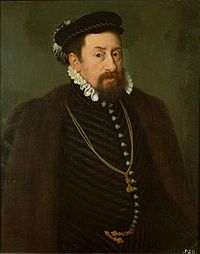 |
Maximilian Maximilian II, Holy Roman Emperor Maximilian II was king of Bohemia and king of the Romans from 1562, king of Hungary and Croatia from 1563, emperor of the Holy Roman Empire of the German Nation from 1564 until his death... (I. Miksa) |
8 September 1563 | 12 October 1576 | ||
| Rudolf I Rudolf II, Holy Roman Emperor Rudolf II was Holy Roman Emperor , King of Hungary and Croatia , King of Bohemia and Archduke of Austria... |
25 September 1572 | 26 June 1608 | |||
 |
Matthias II Matthias, Holy Roman Emperor Matthias of Austria was Holy Roman Emperor from 1612, King of Hungary and Croatia from 1608 and King of Bohemia from 1611... (II. Mátyás) |
26 June 1608 | 20 March 1619 | ||
| Ferdinand II Ferdinand II, Holy Roman Emperor Ferdinand II , a member of the House of Habsburg, was Holy Roman Emperor , King of Bohemia , and King of Hungary . His rule coincided with the Thirty Years' War.- Life :... |
1 July 1618 | 15 February 1637 | |||
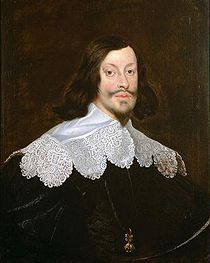 |
Ferdinand III Ferdinand III, Holy Roman Emperor Ferdinand III was Holy Roman Emperor from 15 February 1637 until his death, as well as King of Hungary and Croatia, King of Bohemia and Archduke of Austria.-Life:... |
8 December 1625 | 2 April 1657 | ||
| Ferdinand IV Ferdinand IV of Hungary Ferdinand IV was King of the Romans, King of Hungary, and King of Bohemia.He was born in Vienna, the eldest son of Ferdinand III, Holy Roman Emperor and his first wife Maria Ana of Spain... |
16 June 1647 | 9 July 1654 | He died in 1654, predeceasing his father. | ||
 |
Leopold I Leopold I, Holy Roman Emperor | style="float:right;" | Leopold I was a Holy Roman Emperor, King of Hungary and King of Bohemia. A member of the Habsburg family, he was the second son of Emperor Ferdinand III and his first wife, Maria Anna of Spain. His maternal grandparents were Philip III of Spain and Margaret of Austria... (I. Lipót) |
27 June 1655 | 5 May 1705 | Habsburgs began colonization of Serbs Serbs The Serbs are a South Slavic ethnic group of the Balkans and southern Central Europe. Serbs are located mainly in Serbia, Montenegro and Bosnia and Herzegovina, and form a sizable minority in Croatia, the Republic of Macedonia and Slovenia. Likewise, Serbs are an officially recognized minority in... (1690) and Germans Germany Germany , officially the Federal Republic of Germany , is a federal parliamentary republic in Europe. The country consists of 16 states while the capital and largest city is Berlin. Germany covers an area of 357,021 km2 and has a largely temperate seasonal climate... (1682–1699) in Southern Hungary. |
|
| Hungary reunited under Habsburg rule after the Great Turkish War Great Turkish War The Great Turkish War refers to a series of conflicts between the Ottoman Empire and contemporary European powers, then joined into a Holy League, during the second half of the 17th century.-1667–1683:... in 1699. |
|||||
| Joseph I Joseph I, Holy Roman Emperor Joseph I , Holy Roman Emperor, King of Bohemia, King of Hungary, King of the Romans was the elder son of Emperor Leopold I and his third wife, Eleonor Magdalene of Neuburg.... (I. József) |
9 December 1687 | 17 April 1711 | |||
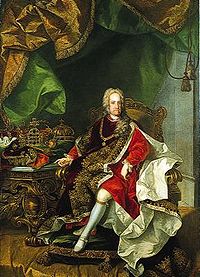 |
Charles III Charles VI, Holy Roman Emperor Charles VI was the penultimate Habsburg sovereign of the Habsburg Empire. He succeeded his elder brother, Joseph I, as Holy Roman Emperor, King of Bohemia , Hungary and Croatia , Archduke of Austria, etc., in 1711... (III. Károly) |
11 April 1711 | 20 October 1740 | Large scale German settlements in Hungary begin (1720–1800). | |
.jpg) |
Maria II Theresa Maria Theresa of Austria Maria Theresa Walburga Amalia Christina was the only female ruler of the Habsburg dominions and the last of the House of Habsburg. She was the sovereign of Austria, Hungary, Croatia, Bohemia, Mantua, Milan, Lodomeria and Galicia, the Austrian Netherlands and Parma... (II. Mária Terézia) |
20 October 1740 | 29 November 1780 | Enjoyed broad support of Hungarian nobles; | |
1780–1944
| Portrait | Ruler | Began | Ended | Remarks |
|---|---|---|---|---|
 |
Joseph II Joseph II, Holy Roman Emperor Joseph II was Holy Roman Emperor from 1765 to 1790 and ruler of the Habsburg lands from 1780 to 1790. He was the eldest son of Empress Maria Theresa and her husband, Francis I... (II. József) |
29 November 1780 | 20 February 1790 | |
| Leopold II Leopold II, Holy Roman Emperor Leopold II , born Peter Leopold Joseph Anton Joachim Pius Gotthard, was Holy Roman Emperor and King of Hungary and Bohemia from 1790 to 1792, Archduke of Austria and Grand Duke of Tuscany from 1765 to 1790. He was a son of Emperor Francis I and his wife, Empress Maria Theresa... (II. Lipót) |
20 February 1790 | 1 March 1792 | ||
| Francis Francis II, Holy Roman Emperor Francis II was the last Holy Roman Emperor, ruling from 1792 until 6 August 1806, when he dissolved the Empire after the disastrous defeat of the Third Coalition by Napoleon at the Battle of Austerlitz... (I. Ferenc) |
1 March 1792 | 2 March 1835 | ||
 |
Ferdinand V (V. Ferdinánd) |
28 September 1830 | 2 December 1848 | Being epileptic and mentally ill, abdicated in favour of his nephew, Franz Joseph (son of his younger brother Franz Karl). Died in 1875. |
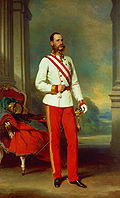 |
Francis Joseph (I. Ferenc József) |
2 December 1848 | 21 November 1916 | Later regained the rule with Russian help in 1849 and was crowned in 1867. |
| Charles IV (IV. Károly) |
21 November 1916 | 16 November 1918 | Reigned until 1918, when he "renounced participation" in state affairs, but did not abdicate. He spent the remaining years of his life attempting to restore the monarchy until his death in 1922. | |
| Portrait | Ruler | Began | Ended | Remarks |
|---|---|---|---|---|
 |
Miklós Horthy Miklós Horthy Miklós Horthy de Nagybánya was the Regent of the Kingdom of Hungary during the interwar years and throughout most of World War II, serving from 1 March 1920 to 15 October 1944. Horthy was styled "His Serene Highness the Regent of the Kingdom of Hungary" .Admiral Horthy was an officer of the... |
1 March 1920 | 3 November 1944 | Navy admiral Horthy officially 'represented' the defunct Hungarian monarchy despite Charles I of Austria's attempts to retake the throne of Hungary Charles I of Austria's attempts to retake the throne of Hungary After Miklós Horthy had been chosen Regent of Hungary on 1 March 1920, Charles I of Austria-Hungary, who had reigned in Hungary as Károly IV, returned to Hungary twice, to try unsuccessfully to retake his throne... . The state was effectively a "kingdom without a king". Dethronization of Habsburgs enacted by Hungarian Parliament in 1921. |
Titular Kings of Hungary
| Portrait | Titular ruler | Began | Ended | Remarks |
|---|---|---|---|---|
| Charles IV (IV. Károly) |
16 November 1918 | 1 April 1922 | He reigned until 1918, when he "renounced participation" in state affairs but did not abdicate. He spent the remaining years of his life attempting to restore the monarchy until his death in 1922. | |
 |
Otto II Otto von Habsburg Otto von Habsburg , also known by his royal name as Archduke Otto of Austria, was the last Crown Prince of Austria-Hungary from 1916 until the dissolution of the empire in 1918, a realm which comprised modern-day Austria, Hungary, Bosnia and Herzegovina, Croatia, the Czech Republic, Slovakia,... (II. Ottó) |
1 April 1922 | 4 July 2011 | On 31 May 1961, Otto renounced all claims to the Austrian throne. However, he did not renounce all claims to the Hungarian and Bohemian throne, and the Communists did not request this. |
| Charles V (V. Károly) |
4 July 2011 | Incumbent | He serves as Head of House of Habsburg since January 2007. | |
External links
See also
- List of Queens of Hungary
- List of heads of state of Hungary
- List of Prime Ministers of Hungary
- List of palatines of Hungary

